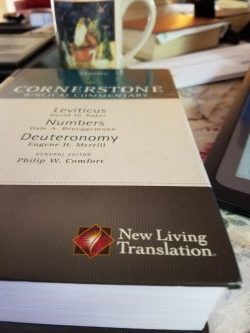A Note on Translations and Commentaries

As I’ve been reading a commentary based on the New Living Translation (NLT), it has been interesting to note how the commentators differ from the readings of the translation on which the commentary is ostensibly based.
For example, as I finished reading the section on Numbers today (pp. 217-443), written by Dale A. Brueggemann, I noted two important translation notes.
- 35:12, in which the NLT refers to “relatives” rather than to the singular “goel” or avenger/redeemer, a translation that the commentator says “… may be misleading” (p. 426n). Certainly potentially misleading and may cause one to miss connecting thoughts built on this concept.
- 35:20, in which two points are noted. First, the NLT adds “a dangerous object” which is not in the Hebrew source, and also omits “while lying in wait,” which is in the Hebrew. The latter omission the commentator calls “this telling qualification” (p. 427n).
It’s not surprising that a commentator will work for the source text, of course, but it’s interesting to note. You’ll find this sort of disagreement in almost any commentary where the author is required to use a particular translation. Sometimes one could almost say “with the ___ version included” rather than saying it’s a commentary on that version.
With a dynamic equivalence translation, however, the odds are greater that there will be a certain tension between commentator and English text. This is not really surprising. Is it problematic? For many, this disagreement is an argument in favor of more formal equivalence translations.
It seems to me, however, that a formal equivalence translation, besides allowing for misunderstanding, such as when it verbally translates some idioms, also simply leaves greater room for one to imagine the translation agrees with one’s own approach, even when it’s simply a bit ambiguous.
It’s valuable for lay persons who read scripture to become aware of the fact that there are differences in the way translations are done. That’s why I frequently recommend reading from more than one translation. For example, a good counterpoint to the NLT might be the New Revised Standard Version (which also provides from more theological diversity in the translation committee) or the English Standard Version (with an evangelical team similar to that of the NLT).